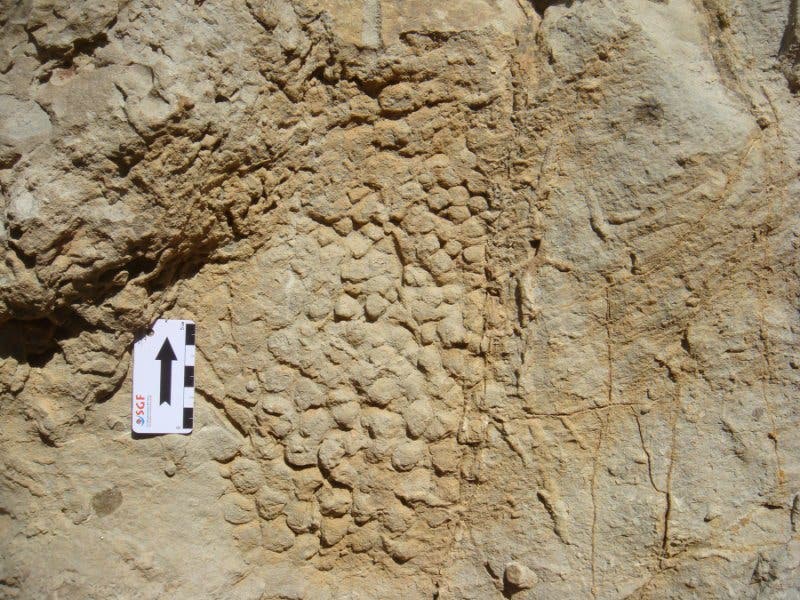Researchers from the Universitat Autònoma de Barcelona (UAB) working in collaboration with the Institut Català de Paleontologia Miquel Crusafont (ICP), have discovered an impression fossil preserving a Late Cretaceous dinosaur’s skin texture. This marks the time right before their extinction, making the fossil a unique discovery in Europe.
While performing a geological survey near the village of Vallcebre near Barcelona to study the origins of Late Cretaceous rock sediments (roughly 66 millions of years old), researchers found the impression of a dinosaur’s scales. They suspect the fossil formed when the animal had laid down in the mud, as the area corresponded to the muddy banks of a river during that time. The imprint was covered with sand which lithified into sandstone, preserving the relief of the animal’s original skin.
The Late Cretaceous ended with the extinction of the dinosaurs due to a violent meteorite impact. As such, there are very few places on Earth where intact sandstone deposits can be found from this period, making the find unique. Finding data to characterize these late dinosaurs is very important in understanding how they dealt with the extreme conditions and why they disappeared.
“This is the only registry of dinosaur skin from this period in all of Europe, and it corresponds to one of the most recent specimens, closer to the extinction event, in all of the world,” highlights UAB researcher Victor Fondevilla, main author of the research. “There are very few samples of fossilised skin registered, and the only sites with similar characteristics can be found in United States and Asia.”
“Other dinosaur skin fossils have been found in the Iberian Peninsula, in Portugal and Asturias, but they correspond to other more distant periods,” he adds.
The fossil shows scales in a pattern characteristic to some carnivorous dinosaurs and hadrosaurs: a central polygon-like bump surrounded by fire or six more bumps in the form of a rose. But the scales are too large compared to the typical size found in the dinosaurs roaming the area 66 million years ago.
“The fossil probably belongs to a large herbivore sauropod, maybe a titanosaurus, since we discovered footprints from the same species very close to the rock with the skin fossil,” Fondevilla says.
In fact, two skin impressions were found, one measuring approximately 20 centimeter wide, and the other slightly smaller, measuring only 5 centimeter wide, separated by a 1.5 meter distance and probably made by the same animal.
The fact that they are impression fossils is evidence that the animal is from the sedimentary rock period, one of the last dinosaurs to live on the planet. When bones are discovered, dating is more complicated because they could have moved from the original sediment during all these millions of years,” Fondevilla adds.
The find will allow scientists to better recreate the dinosaurs before their extinction.
“The sites in Berguedà, Pallars Jussà, Alt Urgell and La Noguera, in Catalonia, have provided proof of five different groups of dinosaurs: titanosaurs, ankylosaurids, theropods, hadrosaurs and rhabdodontids,” explains Àngel Galobart, head of the Mesozoic research group at the ICP and director of the Museum of Conca Dellà in Isona.
“The sites in the Pyrenees are very relevant from a scientific point of view, since they allow us to study the cause of their extinction in a geographic point far away from the impact of the meteorite.”
The full paper “Skin impressions of the last European dinosaurs” has been published in the journal Geological Magazine.










